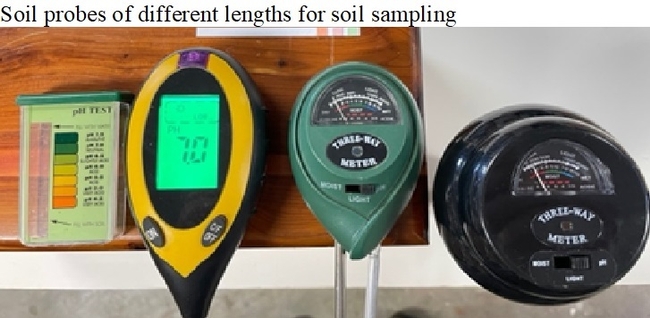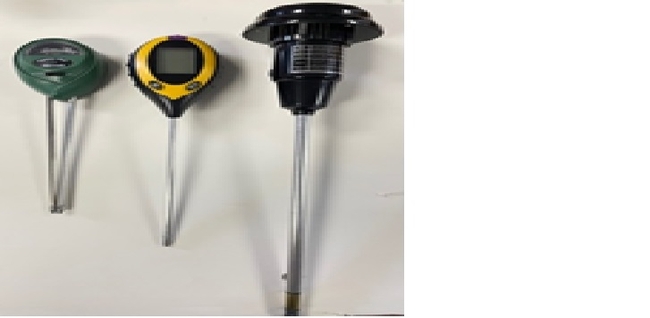Okay, be honest. When you have a plant that is not doing well and you look for help from your favorite book, website, or YouTube source, and they start talking about pH, do your eyes roll back?
First, let's define the term. In 1909 Danish biochemists decided to use pH as shorthand for potential hydrogen. They developed a pH scale, ranging from 0 to 14, to represent how many hydrogen ions (H+) are present in a sample. According to the scale, distilled water is a 7 (neutral). Anything under seven is considered acidic (sour), while anything above 7 is alkaline (sweet).
These values are not linear but, rather, logarithmic. That means that a sample with a pH of 6 is 10 times more acidic than a sample with a pH of 7.
What does pH have to do with gardening? Everything. A soil's pH affects the ability of plant roots to absorb nutrients and water. Most minerals in the soil must be dissolved to be absorbed by a plant's roots. Soil that is slightly acidic (6.2 to 6.8) or slightly alkaline (7.4 to 7.8) will dissolve minerals the best.
When soil is too acidic (pH below 5.5) new foliage looks yellow, distorted and possibly black around the edges and the plant does not grow. When soil is alkaline (pH above 8), plant leaves may look yellow between the veins or have a bleached or mottled and blotchy look. New growth may have brown or black leaf tips.
If you read that last paragraph again, you'll notice that the symptoms of pH imbalance are roughly the same, whether pH is too high or too low. That's indeed true but once you know the target soil pH for your plant, you can find information on how to adjust it.
The key point is that hydrogen drives the process of photosynthesis in the leaves and plant respiration in the roots. Both functions promote plant growth and health. Too much hydrogen or too little can reduce a plant's viability. Just like Goldilocks, you are looking for “just right.”
So don't think of pH as a scary word. Rather, think of it as the Teeter Totter of garden soil. Let's say you test your soil and find that it has a pH of 7.5 but you want it at 6.8. Adding acidic soil amendments, such as pine needles or coffee grounds, or an acid fertilizer, can shift the fulcrum. And a change in pH can be powerful. Just lowering the soil pH to a range of 5.2 to 5.5 can turn a pink hydrangea blue.
But be aware that it can take months for soil amendments to make a difference. If you rotate crops, the pH of the soil you amended last year may not be the best for this year's veggies. Save yourself some grief and experiment on smaller areas, such as planter boxes, rather than trying to adjust pH on a large plot. Test the soil a couple of times a year and make smaller adjustments frequently.
Of course, the best way to get accurate information about your soil's pH is to send samples to a laboratory for testing. For a fee, they will analyze your soil samples, but this can get pricy.
If you are a DYI person, start out with a small defined plot. Wearing gloves, take samples from four to five areas at a depth of four to six inches. Combine the samples in a clean, dry bucket. Remove debris such as sticks, rocks or dead plant parts. Add distilled water until the soil is a thick paste. Then dip your testing device into the bucket and follow the key on the packages to determine the pH of your sample.
Finally, with results in hand, you can amend the soil to achieve the desired pH. Not sure what amendments to use? Ask the staff at your local nursery. Read the labels on amendments for instructions. Study up on the nutritional requirements of your plant to know if you even need to correct the pH. Or contact the Napa County Master Gardener help desk (hours below). When you learn how to test and amend your own soil, you won't think of pH as a frightening term anymore. In fact, when your plants start to look great, you will be pH (pleasantly happy).
Fall Faire: Join the UC Master Gardeners of Napa County for an entertaining and educational event on Saturday, September 28, from 1 pm to 4 pm, outdoors at University of California Cooperative Extension, 1710 Soscol Avenue, Napa. Enjoy exhibits on composting, monarch butterflies, succulents, water conservation, bees and more. The program includes activities for kids, a scarecrow contest, giveaways, and music. Admission is free.
Library Talk: Join UC Master Gardeners of Napa County and Napa Public Library for a free talk on “Thirsty Lawn to Low-Water Succulents and Perennials: A Step-by-Step Guide” on Thursday, October 3, from 7 pm to 8 pm, via Zoom. Don't let analysis paralysis stop you from achieving your new climate-appropriate garden. Join the UC Master Gardeners of Napa County on a step-by-step journey from weedy, labor-intensive lawn to a garden of succulents and perennials with year-round color. Register here.
Become a Master Gardener Volunteer: UC Master Gardeners of Napa County is now accepting applications for the Class of 2025. Visit napamg.ucanr.edu to read the informational brochure, then register to attend a mandatory information session for applicants. Application deadline is 5 pm on September 25.
Help Desk: The Master Gardener Help Desk is available to answer your garden questions on Mondays and Fridays from 10 am until 1 pm at the University of California Cooperative Extension Office, 1710 Soscol Avenue, Suite 4, Napa. Or send your questions to mastergardeners@countyofnapa.org. Include your name, address, phone number and a brief description.

